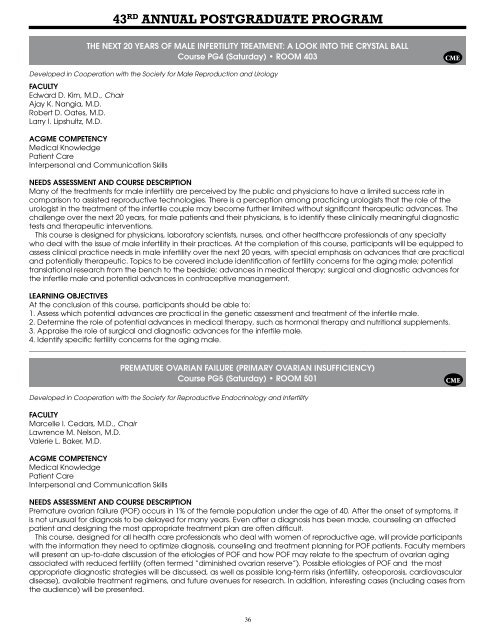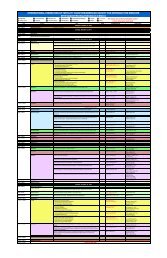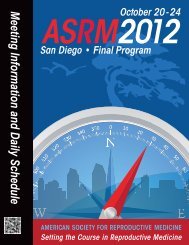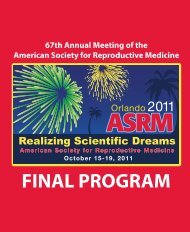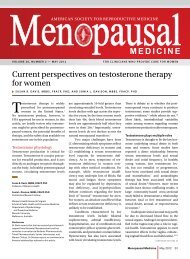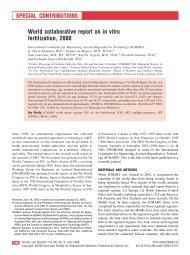scientific program • symposia - American Society for Reproductive ...
scientific program • symposia - American Society for Reproductive ...
scientific program • symposia - American Society for Reproductive ...
You also want an ePaper? Increase the reach of your titles
YUMPU automatically turns print PDFs into web optimized ePapers that Google loves.
43 RD ANNUAL POSTGRADUATE PROGRAM<br />
Developed in Cooperation with the <strong>Society</strong> <strong>for</strong> Male Reproduction and Urology<br />
FACULTY<br />
Edward D. Kim, M.D., Chair<br />
Ajay K. Nangia, M.D.<br />
Robert D. Oates, M.D.<br />
Larry I. Lipshultz, M.D.<br />
ACGME COMPETENCY<br />
Medical Knowledge<br />
Patient Care<br />
Interpersonal and Communication Skills<br />
NEEDS ASSESSMENT AND COURSE DESCRIPTION<br />
Many of the treatments <strong>for</strong> male infertility are perceived by the public and physicians to have a limited success rate in<br />
comparison to assisted reproductive technologies. There is a perception among practicing urologists that the role of the<br />
urologist in the treatment of the infertile couple may become further limited without significant therapeutic advances. The<br />
challenge over the next 20 years, <strong>for</strong> male patients and their physicians, is to identify these clinically meaningful diagnostic<br />
tests and therapeutic interventions.<br />
This course is designed <strong>for</strong> physicians, laboratory scientists, nurses, and other healthcare professionals of any specialty<br />
who deal with the issue of male infertility in their practices. At the completion of this course, participants will be equipped to<br />
assess clinical practice needs in male infertility over the next 20 years, with special emphasis on advances that are practical<br />
and potentially therapeutic. Topics to be covered include identification of fertility concerns <strong>for</strong> the aging male; potential<br />
translational research from the bench to the bedside; advances in medical therapy; surgical and diagnostic advances <strong>for</strong><br />
the infertile male and potential advances in contraceptive management.<br />
LEARNING OBJECTIVES<br />
At the conclusion of this course, participants should be able to:<br />
1. Assess which potential advances are practical in the genetic assessment and treatment of the infertile male.<br />
2. Determine the role of potential advances in medical therapy, such as hormonal therapy and nutritional supplements.<br />
3. Appraise the role of surgical and diagnostic advances <strong>for</strong> the infertile male.<br />
4. Identify specific fertility concerns <strong>for</strong> the aging male.<br />
________________________________________________________________________________________________________________________<br />
Developed in Cooperation with the <strong>Society</strong> <strong>for</strong> <strong>Reproductive</strong> Endocrinology and Infertility<br />
FACULTY<br />
Marcelle I. Cedars, M.D., Chair<br />
Lawrence M. Nelson, M.D.<br />
Valerie L. Baker, M.D.<br />
THE NEXT 20 YEARS OF MALE INFERTILITY TREATMENT: A LOOK INTO THE CRYSTAL BALL<br />
Course PG4 (Saturday) <strong>•</strong> ROOM 403 CME<br />
ACGME COMPETENCY<br />
Medical Knowledge<br />
Patient Care<br />
Interpersonal and Communication Skills<br />
PREMATURE OVARIAN FAILURE (PRIMARY OVARIAN INSUFFICIENCY)<br />
Course PG5 (Saturday) <strong>•</strong> ROOM 501<br />
NEEDS ASSESSMENT AND COURSE DESCRIPTION<br />
Premature ovarian failure (POF) occurs in 1% of the female population under the age of 40. After the onset of symptoms, it<br />
is not unusual <strong>for</strong> diagnosis to be delayed <strong>for</strong> many years. Even after a diagnosis has been made, counseling an affected<br />
patient and designing the most appropriate treatment plan are often difficult.<br />
This course, designed <strong>for</strong> all health care professionals who deal with women of reproductive age, will provide participants<br />
with the in<strong>for</strong>mation they need to optimize diagnosis, counseling and treatment planning <strong>for</strong> POF patients. Faculty members<br />
will present an up-to-date discussion of the etiologies of POF and how POF may relate to the spectrum of ovarian aging<br />
associated with reduced fertility (often termed “diminished ovarian reserve”). Possible etiologies of POF and the most<br />
appropriate diagnostic strategies will be discussed, as well as possible long-term risks (infertility, osteoporosis, cardiovascular<br />
disease), available treatment regimens, and future avenues <strong>for</strong> research. In addition, interesting cases (including cases from<br />
the audience) will be presented.<br />
36<br />
CME


